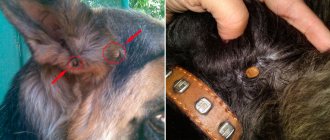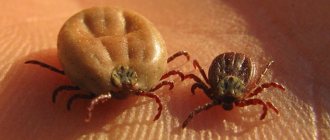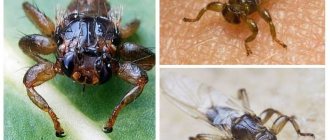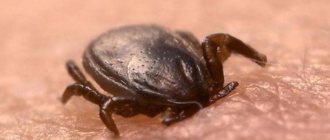Features of the disease
Otodecosis in cats is caused by the microscopic (about ½ mm) insect Otodectes cynotus.
The parasite has a whitish oval body and jointed limbs. It loves moisture and warmth, so it parasitizes inside the animal’s ear canal, feeding on skin scales, blood, and lymph. Outside the host's body, the tick can live for about two months. In most cases, the parasite affects both ears of the cat. The likelihood of infection is especially high during the warm and humid seasons - spring and early autumn. The risk group includes kittens under one year old and weakened animals. It may take several years from the moment of infection to obvious signs of the presence of a tick. The disease manifests itself especially clearly when a bacterial infection is added to the skin damage by the parasite. Due to itching and pain, an exhausted pet cannot sleep or eat.
Routes of infection
Cats become infected with ear mites through contact with sick animals, as well as through equipment and household items - carpets, beds. People sometimes become carriers of parasites. Ticks can end up on the cat owner's shoes or clothing and then end up on the pet's fur.
Young animals suffer from otodectosis more often than adults. Kittens aged from birth to one year are at risk, as they have weak immunity.
Infection most often occurs in spring or summer, because at positive temperatures, ear mites live longer in the external environment. Parasites do not pose a danger to humans; people do not suffer from otodectosis.
The danger of ear mites for cats
Ear mites feed on skin particles, causing severe damage to the skin. If left untreated, your cat may develop serious health problems:
- unbearable itching causes constant scratching of the ears, which leads to damage to the capillaries and the appearance of extensive hematomas;
- Bacterial and fungal infections penetrate into places where the skin is damaged, the inflammatory process begins, the ear tissues swell, redden, and fester;
- gradually the inflammation spreads to the eardrum and to the inner ear - otitis media and myringitis develop.
Further delay with therapy will lead to weakening and then loss of hearing. Pain and itching interfere with normal rest and eating. The animal becomes irritated, nervous, and aggressive. Over time, inflammation can penetrate the membranes of the brain, resulting in death.
Description of ear scabies in cats
Mites live in the external auditory canal. They feed on particles of the epidermis. This causes irritation, redness and severe itching in the animal. The parasites' waste products enter the inner ear and poison the body with toxins. Otodectosis is accompanied by a bacterial infection. The animal feels severe discomfort and becomes restless.
Ear scabies can also occur in dogs, but cats are most often affected by this disease. Cat parasites pose no danger to humans. But a person can be a carrier of the infection and infect their pet with ticks. Therefore, it is important to maintain hygiene and cleanliness at home. If cats live in the room, you need to regularly vacuum and wash the floors with disinfectants.
How can a pet become infected?
A cat can pick up ear mites on the street, through contact with sick animals or in walking areas. Most stray cats suffer from otodecosis, so letting your pet roam freely is fraught with negative consequences.
The parasite can be picked up on shoes by the owner while accidentally walking in places where stray cats like to gather. An owner can bring ear mites home after petting someone else's pet with otodecosis. In addition, there is a high probability of disease in homes where there have already been (or are) cases of the disease in other animals.
Kittens can become infected at birth from a mother who is a carrier of ear mites. Infection through bedding, carpets, household furniture or dishes is possible.
How can an animal become infected with ear mites?
Infection of a pet can occur not only during contact with a sick pet; the parasite is able to enter the apartment and attack the animal in various ways:
- use of common animal care items (comb, towel, dishes);
- The furry owner himself can become a carrier, bringing the pest into the house on clothes or shoes, but the cat ear mite does not pose a danger to humans;
- a rug near the door, which is rarely washed and treated with disinfectant solutions, can also be a haven for bloodsuckers;
- Even fleas and flies can carry ticks.
On a note!
Most often, ear mites are observed in a kitten or in a weakened animal. Much less often, the parasite attacks adult cats and female cats.
Ear mites in cats
Symptoms of ear mites in cats
There are practically no symptoms of ear mites in cats at the onset of the disease. You should take your pet to a veterinarian if the following signs of illness are detected:
- frequent scratching of the ears, leading to bruising;
- head shaking, restlessness;
- discharge from the ear canal of liquid, stuck together pieces of sulfur of a dirty gray or dirty brown color;
- glued fur on the ears;
- hair loss in the ear area;
- purulent ulcers on the outer ear;
- swelling and redness of the ears;
- unpleasant odor;
- the animal walks with its head bowed.
You should suspect odecosis if your cat periodically shakes its head and scratches its ears. Discharge, odor and other signs appear later, when the disease takes an advanced form.
What does a parasite look like?
Ear mites or otodectosis is a fairly common disease that affects not only stray animals, but also pets. It is caused by Otodectes cynotis, a small light yellow creature whose length does not exceed 0.6 mm. The inconspicuous carrier of infection has relatively long legs and an oval-shaped body (a photo of an ear mite in cats is presented below).
On a note!
The parasite that lives in the upper layers of the ear canal uses as food not only skin cells, but also lymph, as well as intercellular fluid and blood, which causes a lot of suffering to the cat. The development cycle of the bloodsucker is about 3 weeks. An arthropod can live outside the body of an animal for no more than two months. In the absence of food sources (prey), the pest dies.
Diagnosis of otodecosis
Even if there are seemingly obvious signs of ear mites, the cat should be shown to a veterinarian. Similar symptoms may appear with dermatoses, lichen, fungal and bacterial infections. In addition, there is another type of external microscopic parasite that lives on the ears of cats. Therefore, before starting treatment, a diagnosis is required.
The diagnosis is made based on examination and microscopic examination of scrapings from the surface of the auricle. Under a microscope, the doctor will quickly identify the parasite and prescribe appropriate treatment.
If laboratory diagnostics are not possible, you can try the home method. To do this you will need a black sheet of paper and a magnifying glass. You need to take a little discharge from the inner surface of your pet’s ear and smear it on paper. If there is a parasite, then on the leaf it looks like a moving whitish dot.
Establishing diagnosis
You can treat ear mites in cats at home, but first you need to confirm the diagnosis. Before going to the veterinary clinic, you should not clean or wipe your cat’s ears.
There are several ways to diagnose otodectosis:
- Examining a cat using an otoscope.
- A positive test for the ear-pedal reflex (when palpating or cleaning the shell, the cat makes movements with its hind paw on the same side of the body, as if trying to scratch a sore ear).
- Microscopy. The doctor takes a scraping from the skin inside the ear canal. With multiple magnification, under a microscope it is possible to examine mites, their eggs or larvae.
Differential diagnosis
When diagnosing an ear mite infestation, it is important to exclude other diseases whose manifestations are similar to otodectosis:
- notoedrosis;
- hypersensitivity to flea bites;
- otitis externa caused by a fungal infection.
Medicines for ticks
Medicines for ear mites are available in the form of ointments or drops. Among the large assortment, it is difficult to choose the right remedy on your own: you should take into account the degree of damage, the presence of concomitant infections, and the age of the animal. In the treatment of otodecosis, the medications listed below are most often used.
A drug
Course of treatment, dosage
Note
Amidel
The gel is applied to the cleaned surface of the ear 3-5 times at intervals of one week.
Do not use on kittens under 2 months of age or on cats during pregnancy.
Otoferonol Gold
Apply twice with a break a week. Dosage – 3 drops in each ear.
Do not use on kittens under two months of age or pregnant cats. The product destroys the parasite and has an anti-inflammatory effect.
Aversectin ointment
Apply 2-4 times, interval – 7 days.
Do not apply the ointment to kittens under 2 months of age or during pregnancy.
Amitrazine
The course of treatment includes 4-5 procedures. The breaks between instillations are three days. Dosage – ½ ml in one ear.
Not for use in pregnant cats.
Dekta
Ear drops are used every five days, 4-5 drops once. A total of 2-4 procedures are required.
The product is not suitable for babies under 30 days old and pregnant cats. The composition includes an antibacterial component.
In difficult situations, the veterinarian will prescribe injections or antibacterial drugs.
Signs of tick infection
Veterinarians and experienced cat owners know how to identify ear mites. Most often, small kittens (1-6 months), as well as old or weakened cats, experience otodectosis.
Ear mites in cats, signs:
- the pet often shakes its head and at the same time rattling can be heard;
- the shell of the ears is filled with black sulfur with the subsequent formation of dense plugs;
- when shaking your head, liquid drops spray from your ears;
- the animal develops bleeding wounds due to scratching;
- sticking of fur around the ear due to the flow of pus from it;
- the pet has a high temperature;
- the animal experiences nervous attacks and becomes aggressive;
- the ears exude a stench.
Along with the above signs, the animal atypically tilts its head, trying to lower the sore ear.
If at least one sign appears, it is advisable to visit a doctor.
How to treat the ears
You need to treat the ears of your furry pet as follows.
- Before using the medicine, the cat's ears are cleaned of accumulated plaque. This will allow the medicine to penetrate deeper. For cleansing, use special solutions or regular vegetable oil. The surface of the ear is wiped with a cotton pad or a piece of bandage soaked in the solution. Hydrogen peroxide or other agents should not be instilled into the ear canal!
- Apply ointment or drops to the clean surface of the auricle in the amount specified in the instructions for the drug.
- To ensure that the medicine is distributed evenly, the ear needs to be massaged a little.
- If drops are used, the cat's head should be supported to prevent shaking and the medicine being thrown out.
- In conclusion, it is recommended to wipe the auricle again with a cotton pad soaked in the same product.
Attention: it is not recommended to use cotton swabs to treat the ears of an animal - the likelihood of injury to the ear canal and infection in the deep parts of the ear increases.
Symptoms
A tick in a cat's ear will make itself felt literally from the moment it appears.
- The animal begins to show anxiety and try to scratch its ears in any possible way: with its paws, by rubbing against hard surfaces. Constant itching will make her nervous and aggressive. In addition, constant attempts to scratch the ear will lead to scratches and open wounds that may become inflamed and begin to fester, so the itching will intensify. It is impossible to let the disease progress to such a state, as this may result in the eardrum bursting and the inflammation penetrating deeper into the inner ear.
- The cat begins to shake its head frequently, trying to get rid of the cause of scabies in the ear.
- Swelling is observed in the areas where the tick is located due to the fact that the vessels are overflowing with blood.
- On damaged surfaces there is exudate - liquid secretions. When it dries and mixes with skin particles and waste products of mites, brown scabs appear.
- The ear canal becomes crusty and then plugged.
- Even from a distance you can smell an unpleasant odor from a cat's ear.
- At a later stage of the disease, purulent masses stick together the fur at the base of the ear.
- In the later stages of the disease, your cat may experience hearing loss, although this can be difficult to test.
- An indirect sign of ear mites in cats may be fever or lethargy.
Ear mite photo
If any of these signs occur, and especially if they are accompanied by an increase in temperature, you should contact your veterinarian for professional help.
Concomitant therapy
When treating ear mites, you need to keep in mind that the parasite can spread to the cat’s body, so in parallel with treating the ears, antiparasitic procedures for the whole body should be carried out. To do this, just apply a few drops of a special preparation to the pet’s scruff or treat it with a spray. Among the sprays, the most popular are Frontline and Cyodrin. It is imperative to ensure that the animal does not lick its fur for a certain period of time.
You should also take care of your furry pet’s immune system. The stronger the immune system, the faster the recovery, and the greater the chance of avoiding re-infection. A cat's diet should contain a large amount of vitamins and be varied. You can add ready-made vitamin complexes to the food. It is also recommended to carry out a course of therapy with drugs that enhance the body’s defenses - Gamavit, Tentravit.
Treatment with folk remedies
Treatment with folk remedies is permissible only at the very beginning of the development of the disease. In case of obvious symptoms of ear mites, they are suitable only as auxiliary methods. In addition, folk recipes can be used to prevent odecosis.
One of the most common cat ear care products is green tea. Its strong infusion acts as an antiseptic. After the brew has cooled, soak a cotton pad in it and wipe the external auditory canal. The decoction can be used both to cleanse the ears before instilling drops, and for regular care.
Hydrogen peroxide is used in the same way. It cannot be instilled into the ears; it is only allowed to moisten the crusts and wipe the surface of the cartilage.
Vegetable oils are widely used to clean the ears. Any oil will do: olive, sunflower, vaseline, camphor-based. Oils are not suitable for preventing the disease, but they can soften and remove scabs. After applying the oil, the animal’s ears should be wiped with a clean disk so that the oil film does not interfere with the absorption of the medicine.
Sometimes it is recommended to use garlic pulp or juice to combat ear mites in cats, but its irritant properties in this case will be stronger than its antiseptic properties. In addition, garlic will still not be able to destroy the parasite, so this remedy should be abandoned.
Development of a parasitic disease
The disease goes through several stages, each of which is characterized by its own characteristics. Otodectosis progresses slowly. Ultimately, ear scabies leads to inflammation of the brain membrane and painful death of the animal.
First, the parasite enters the cat's ear. The tick injures the skin mechanically. The nerve endings of the ear canal are irritated by the waste products of the parasite. This causes pain in the animal. Hyperemia gradually develops - swelling of the subcutaneous vessels. Swelling of the epidermis is observed. Exudate begins to separate from the ear, which dries and turns into brown scabs.
According to statistics, otodectosis mainly affects kittens and young animals under 1 year of age.
The ear canal is covered with dark crusts that form plugs. This worsens the cat's hearing and negatively affects the animal's well-being. Without treatment, the eardrum bursts under the pressure of the plugs. Parasites penetrate the inner ear. Extensive inflammation and labyrinthitis develop.
Main rules of treatment
When treating odecosis at home, you need to follow a number of recommendations.
- If there are several animals in the house, all of them need to be treated for ticks, regardless of the presence or absence of the parasite. It is better for kittens and cats to use spray products during pregnancy.
- Be sure to treat your pet's bedding with an antiparasitic agent. If possible, it should be boiled.
- Until the product applied to the withers has dried, it is important to monitor the cat, preventing it from licking itself.
- Since recovery depends on the state of the immune system, it is necessary to provide your pet with a balanced diet and include vitamin complexes in it. Periodically take the animal out into the fresh air.
- Ear mites can also live on furniture, carpets, floor cracks and other objects, so wet cleaning should be done by adding an acaricidal agent to the water.
- Do not use ethyl alcohol-based products to clean your cat's ears.
Otodectosis in cats: treatment
It is not difficult to make sure that an ear mite has appeared on a cat. Cotton swabs and dark fabric will help to detect the pest, against which it will be easier to see the parasites. There are two ways to verify the presence of a tick:
- Having grabbed the ear discharge with a cotton swab, you should shake it over the decomposed material, trying to shake off the pest. It will be clearly visible on dark fabric.
- You can also examine the parasite in bright light using a magnifying glass. It is better to do this again against a background of dark fabric. There will be no doubt if you manage to notice movement in the sulfur-purulent mass.
To cure ear mites, it is better to contact a veterinary clinic, where an experienced specialist will determine the type of pest and prescribe the appropriate treatment option. After that, you will have to carry out treatment at home yourself.
The main thing is to be patient, since therapy for getting rid of parasites requires a lot of effort and time. However, the result will not be long in coming; it is only important to adhere to the following recommendations:
- The first stage is the removal of secretions and waste products of parasites that have accumulated in the ear canal. To do this, you need to thoroughly clean the cat's ears with hydrogen peroxide or lotion.
- The next step is to treat the inner surface of the ear with a medicine prescribed by a doctor (ointment, drops or spray), which will promote the healing of the resulting wounds.
- To relieve itching, you can give your pet an antihistamine, and use a special collar to prevent your cat from scratching the affected area.
- After this, the cat’s body is treated with acaricidal compounds, which can not only get rid of pests, but also prevent the attack of new parasites.
- If there are several pets in the house, healthy ones should be isolated from the sick one.
- Do not violate the medication regimen prescribed by your veterinarian.
- It is also mandatory to treat the apartment against ear mites, which will help limit the spread of pests.
Treatment of otodectosis
Are there strong remedies for ear mites?
There is a stronger way to get rid of ear mites than ointments and drops. These are injections. Their distinctive feature is that you can get rid of all parasitic insects at the same time (if they are present). At the same time, the use of this method is fraught with negative consequences - the active substances are toxic to the cat’s body. Their use can provoke allergies, baldness, dermatoses and other complications. The use of such drugs is contraindicated during pregnancy and for kittens.
How to prevent otodecosis
In most cases, tick damage to a cat's ears can be prevented. To do this, you should adhere to the following preventive measures:
- periodically inspect your pet’s ears for scratching, redness, swelling, and scabs;
- regularly clean the external auditory canal;
- do not allow communication with unfamiliar animals;
- strengthen the cat's immune system.
Paying close attention to your pet and promptly seeing a doctor will help avoid health problems.
How does otodectosis become infected?
The carpet beetle mite is the causative agent of ear scabies. You can become infected with it from an already sick animal or through pet care products. The parasite itself or its eggs get on the cat's skin. During the incubation period, there are no obvious symptoms of the disease. But the cat is a potential carrier of this tick. If there are other animals in the house or apartment, then they may well become infected with otodectosis from it.
People can also infect a cat with ear mites. The parasite is very small and can only be seen under a microscope. It can be present on human shoes, clothing and skin. At the same time, this does not pose a danger to people, but cats may well acquire the disease in a similar way. Veterinarians recommend protecting cats from contact with shoes, outerwear, bags, etc.
Fleas and flies are carriers of otodectosis. Quite often, not only mites are found in cats, but also parasites in their fur. In this case, the veterinarian will first prescribe flea drops and then begin treating the ears. As a preventive measure, doctors advise protecting pets from contact with stray cats. It is necessary to periodically clean your ears with special lotions and sprays. The appearance of black growths in the ears, unpleasant odor and wounds cannot be ignored. This symptomatology indicates the possible development of otodectosis. In this case, the best decision is to contact a veterinarian.











